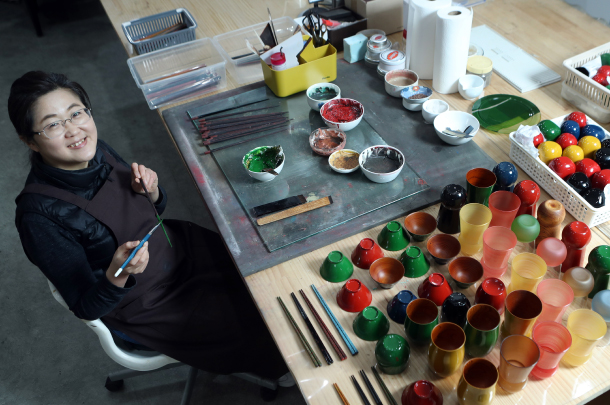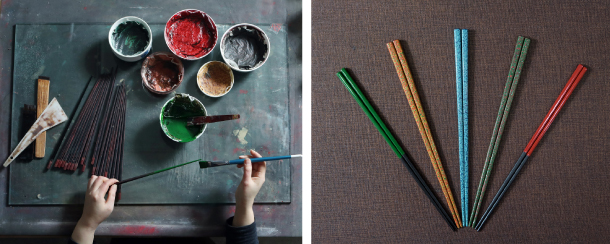Artist adds special touch to an elegant tradition: Ottchil requires a great deal of patience and an eye for delicate beauty

Ottchil artist Jeong Eun-jin poses for a photo at her studio in Gwangjin District, eastern Seoul. Ottchil is traditional technique of using sap from lacquer trees. [KIM SEONG-RYONG]
Wooden housewares coated with sap cultivated from lacquer trees have been long admired for their beautiful shimmer and sturdiness.
The traditional technique is called ottchil, or lacquer varnish, and it is known to make containers resistant to insects, water and humidity.
Due to many benefits the traditional technique possesses, wooden containers finished with ottchil have long been considered high-quality products.
But with the advent of many alternatives for wood from plastic to stainless steel and glass, wood containers are not as common as they used to be, and the traditional technique is no longer in high demand. Some people are, however, making crafts using the lacquer technique and adding modern touches of their own.
Jeong Eun-jin is one of those people. The 46-year-old ottchil artist opened a studio of her own called JL Contemporary in the hope of making products that could be used in everyday life.
She makes cups and utensils in various shapes and size. Her products come in bold, bright colors and zany designs to appeal to younger consumers today.
“This cup with the wide bulging bottom was originally made by my own father but I made up [for some of the weak points in the cup] and continue using the design. My father reinterpreted the design from prehistoric times,” said Jeong.
Jeong grew up watching her father Chung Hae-jo making crafts using ottchil. Chung is famous both at home and abroad for blending the traditional technique with contemporary art.
Chung’s technique is starkly different from other ottchil techniques.
First, a mold is made with wood and then covered with layers of hemp and lacquer. When the hemp and lacquer are all dried up, the wooden mold is scraped out.
When the desired shape comes into existence, Korea’s five traditional colors - red, black, blue, yellow and white - are dabbed on the shape.

Left: Jeong paints ottchil onto chopsticks. Right: More than 20 rounds of ottchil are applied to a pair of chopsticks. [KIM SEONG-RYONG]
The award was launched in 2017 by Loewe, a luxury bag manufacturer, to honor craftsmen across the world.
For Jeong, ottchil was a natural part of her daily life. She majored in ottchil crafts in college, but she didn’t carry on with traditional crafts after that.
“For me, ottchil was my parents’ job. I didn’t think of it as something I wanted to do. So I was away from it for 15 years. I was doing something totally different [for a living]. But I started graduate school for ottchil in 2007 and realized that this is what I have to do for the rest of my life.”
A decade ago, Jeong began making chopsticks and cups using ottchil techniques while working on her own art pieces.
In order to produce unique cups, Jeong uses ash trees. The tree is usually used when making violins.
“They are sturdy. In addition to that, I love the shape of their growth rings. The price is also reasonable. Personally, I prefer zelkova trees [over ash trees] but it’s hard to purchase them as they are mostly used for other things and their prices are not suitable for making everyday necessities.”
A factory that Jeong has been working with for a long time is in charge of carving the wood according to Jeong’s design and drying it.
The most important procedure when producing ottchil crafts is drying.
The wood used for ottchil crafts is steamed at first and then the first round of carving is done, followed by a drying procedure. After drying, the second round of carving is carried out in order to reduce the amount of moisture the wood has in it.
“When ottchil is painted on wood that is not totally dried up, it’s so hard to paint the lacquer. Even if you manage to dab the lacquer on the wood, the shape of a product is likely to get distorted later.”
The sturdiness of ottchil wooden products lies in its complicated drying procedure.
Jeong uses birch wood when making chopsticks and the procedure is no different from making wooden cups because the wood is very hard.
She tries to paint as many thin layers of ottchil as possible on each pair of chopsticks.

Jeong makes wooden cups with wood from ash trees and paints ottchil, or lacquer varnish, onto them after mixing it with various pigments. [SOLUNA LIVING, KIM SEONG-RYONG]
Ottchil is all about repeating the same process over and over again. It is impossible to produce a single product in a short span of time.
“My father repeats painting the lacquer between 80 and 100 times to get a 1 centimeter-thick ottchil,” she said.
Apart from being time-consuming, the lacquer itself is pricey. It comes from drops of sap from lacquer trees.
There are two types of ottchil available. The first is a filtered one and it is called raw chil. Chil means to paint in Korean. The second is refined chil, and it is produced by artisans at the request of customers.
For example, 3.75 kilograms (8.3 pounds) of 100-percent ottchil that comes from lacquer trees grown in Wonju, Gangwon, is priced at around 3 million won ($2,500). The high-quality lacquer is mostly taken by veteran artists first and it is difficult for young artists like Jeong to get their hands on it.
Because of the complicated manufacturing process, ottchil products are quite pricey.
A spoon and chopsticks set created by Jeong costs 100,000 won. Some may think the price is too expensive for a set of wooden cutlery, but once they learn how the utensils are made, they begin to see that the price is pretty reasonable.
“I can make a set [of a spoon and chopsticks] that costs between 20,000 won and 30,000 won, but I can’t paint more lacquer for them [with that price]. [With less ottchil,] the products can’t last very long. You have to throw them away after one or two years of use.
“Instead of doing that, it’s better to buy chopsticks that you can use for 10 years.”
Making cups and spoon sets is not something Jeong puts a priority on, though.
“A lot of people know ottchil as just a finishing technique that adds shimmer to wood and ceramics, but it is more than that, in fact.”
Jeong is interested in applying the natural lacquer to other materials like glass. She also keeps rediscovering the old technique by trying out new things.
When making wooden cups, she covers the outside of the cup with ottchil and the inside with a transparent lacquer so that tree rings appear inside of the cup. Jeong does this to preserve the characteristics of both ottchil and the trees in a single product.
Another experiment she is trying out these days is dabbing ottchil on glass.
Jeong said she gets totally different outcomes when she paints the lacquer inside of a glass cup than when she paints the outside of the cup.
“I want to delve into this sensual pleasure of matching ottchil with wood and glasses,” Jeong said.
BY SEO JEONG-MIN [estyle@joongang.co.kr]










with the Korea JoongAng Daily
To write comments, please log in to one of the accounts.
Standards Board Policy (0/250자)